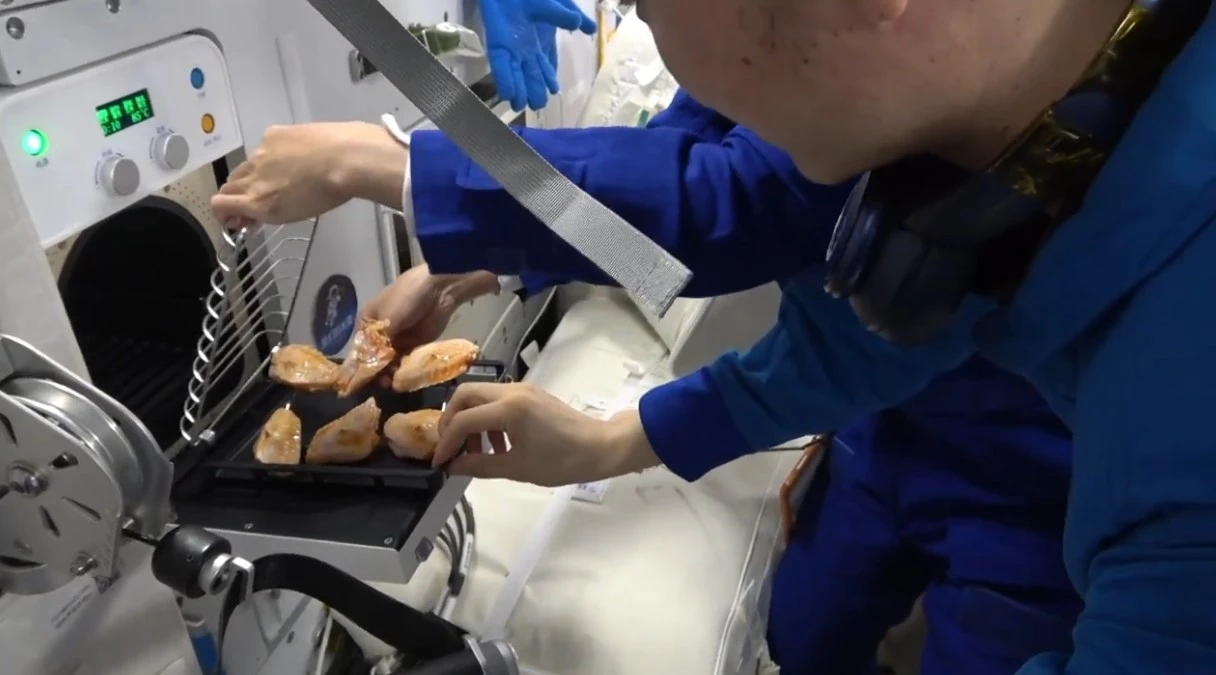First Japan wants to make space sake and now China has been roasting New Orleans-style chicken wings and black pepper steaks in a specially made hot-air oven aboard its Tiangong space station, according to China's Global Times state news service.
Food is vital for maintaining good health and morale – especially under high-stress, isolated conditions. It's one of the reasons why military services spend millions of dollars developing tasty field rations for troops and why submarines pride themselves on their excellent menus. It's also the reason why the old transatlantic liners kept their passengers happy on their journey from Southampton to New York by gorging them like battery geese.
Meanwhile, food aboard the International Space Station and the Tiangong leaves much to be desired, with the menus reading like something more suited to iron rations for a Round Britain yacht race than a decent meal. While they are nutritious, dining on tinned fish, pre-prepared thermostabilized meat, reconstituted scrambled eggs, dehydrated borscht, and vacuum-sealed prawns leaves much to be desired.
With the expansion of commercial spaceflight and planned deep space missions that could last for years, space engineers and culinary experts are working on ways to make meals that are more like those back home as well as developing equipment that will save weight by allowing food to be sent as bulk ingredients instead of precooked dishes with all their packaging.
One example of this is the new oven that has been installed aboard the Tiangong. In a report by the Global Times, the Astronaut Center of China (ACC) says that the appliance was delivered to the space lab aboard the Shenzhou-21 crewed spacecraft on October 31.
To an Earthling, an oven may be just a hot box, but it's actually a very sophisticated piece of equipment that becomes excruciatingly so in space. The major problem is zero gravity. Without gravity, there's no convection, so hot air doesn't rise because there's no "up." Burn a candle, for example, and the flame will quickly smother itself as smoke crowds around the wick with no oxygen to feed it.

A similar thing happens when trying to bake or roast food. The hot air just hangs about, causing the dish to cook unevenly with some spots nearly raw and others burnt. To prevent this, the Chinese space oven is more like an air fryer with fans to circulate the hot air.
Another problem is that of using an oven in a confined space. I can speak from experience, having worked in a tiny, poorly ventilated ship's galley below deck where everything reeked of cooking smells and chip pan oil settled on every conceivable surface, including my eyeglasses. The Tiangong has this even worse with nowhere for fumes to go, so the oven is equipped with a multi-layer filtration system to capture smoke, grease, and other particulates before they could contaminate the station's atmosphere.
In addition to these, the new oven boasts precise temperature control and high-temperature catalysis. Temperatures in the oven are reported to reach 190 °C (374 °F) which is considerably higher than the 100 °C (212 °F) found in other space food heating systems. It also has pre-programmed settings for various dishes and is rated for 500 cycles and the higher temperature means that food can be caramelized, resulting in a crispy texture.

One other thing that cooking on a space station has to deal with that Earthbound chefs don't is that food floats about, which can be aggravating – not to mention alarming when you open the door only to have sizzling-hot steaks jumping out at you. To keep food where it's supposed to be, the oven comes with a cooking rack not dissimilar to the ones campers use to cook fish. This is an open grid to hold the food that folds shut to form a basket.
The inaugural barbecue builds on the work done aboard the ISS, which in 2020 experimented with baking cookies in a special oven. This took up to two hours per batch while the Chinese wings and steaks took only 28 minutes.
The new oven is not only expected to boost morale, but will improve the quality of the astronauts' diets by expanding the 10-day menu to 190 items. However, the oven will likely also pose new challenges. Now that the astronauts have wings, no doubt there will now be a program to supply them with hot sauce, ranch dressing, and celery.
Source: Global Times






